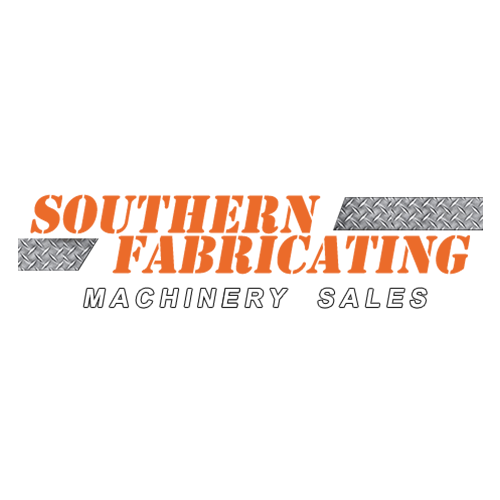Posted By: Andy Kamashian | Posted On: February 26, 2019
Waterjet - Intensifier Vs Direct Drive Which is Better?
This argument is probably as old as the pump technology itself;
‘Which is better an Intensifier style or a Direct Drive Pump?’
While Intensifier pumps are used by far more waterjet manufacturers, one cannot ignore the benefits and simplicity of the direct-drive design, and while there are manufacturers that make and offer both (Flow Corp.) designs, most manufacturers only use readily available “off the shelf” intensifiers style pumps typically designed and built by a third party vendor (like KMT Waterjet, Accustream and American Waterjet). Adversely one of the most successful brands, Omax, uses only Direct-Drive style pumps. Why? What makes one pump design better over the other? Why would you need a different design?
In this article the experts at Southern Fab delve deep into the mystery behind what powers the most popular waterjet cutting systems on the market today. We discover what makes these pumps different in design, performance and even maintenance uncovering both their strengths and weaknesses.
Intensifier Style Pumps
%20AWP%20Freedom%20510-30%20DEMO%20Waterjet%20Cutting%20System%20%20-%20Pic%204-1.jpg?width=300&name=(1852)%20AWP%20Freedom%20510-30%20DEMO%20Waterjet%20Cutting%20System%20%20-%20Pic%204-1.jpg) An intensifier style pump uses the power of hydraulics to “Intensify” the water pressure, usually in a ratio of 20:1 The design starts with an electric (or gas/diesel driven motor) turning a hydraulic pump producing hydraulic oil pressure of around 3,000 PSI. Shown in the illustration below, the hydraulic oil pressure is then fed into the center chamber of a long armored cylinder we call the “Intensifier” it is there that the hydraulic oil pressure moves a piston (or biscuit as it is nicknamed) left and right switching directions and flow once the piston passes a sensor.
An intensifier style pump uses the power of hydraulics to “Intensify” the water pressure, usually in a ratio of 20:1 The design starts with an electric (or gas/diesel driven motor) turning a hydraulic pump producing hydraulic oil pressure of around 3,000 PSI. Shown in the illustration below, the hydraulic oil pressure is then fed into the center chamber of a long armored cylinder we call the “Intensifier” it is there that the hydraulic oil pressure moves a piston (or biscuit as it is nicknamed) left and right switching directions and flow once the piston passes a sensor.
Attached to the piston is a plunger with a diameter 20X smaller then the piston itself. The plunger works in a separately sealed high pressure chamber whereas it draws water in on the retract cycle and then, using the 20:1 ratio, compresses the water, thus “Intensifying” the pressure to 60,000PSI or above. This action cycles approximately 1 stroke per second (depending 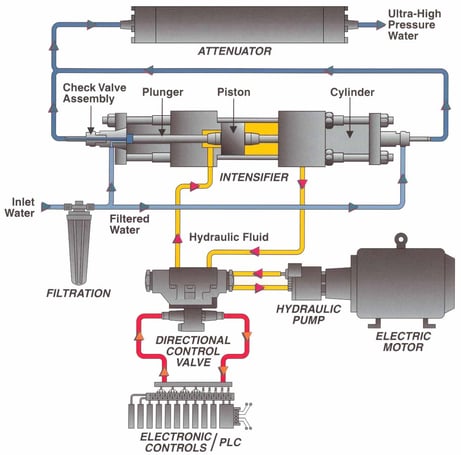 on the intensifier style) sending high pressure water to a storage tank called the Attenuator which is a device meant to soften the pressure spikes from the stroking plungers and deliver a smoother equalized pressure stream to the cutting head.
on the intensifier style) sending high pressure water to a storage tank called the Attenuator which is a device meant to soften the pressure spikes from the stroking plungers and deliver a smoother equalized pressure stream to the cutting head.
Pressures generated on Intensifier style pumps range from 40KPSI (40,000 PSI) upwards of 100KPSI and while pressures can simply be increased on the intensifier style through a change in the ratio of the piston to plunger size and/or in the hydraulic oil pressure produced, the inherent result is that there is less volume of water produced as pressures increase. Also it should be noted that the higher the pressure generated the quicker the internal pump components are to wear and fail. These more frequent maintenance cycles, coupled with the increased component costs and downtime to repair, make these “Ultra-High Pressure" pumps great on paper but often fall very short in practicality. Also it should be noted again that the reaction of increasing pressure reduces the volume of water created at these ultra high pressures thereby reducing cutting efficiency in the long term even further.
Advantages of the Intensifier Style
- Higher pressures available up to 100,000 PSI
- Constant Pressure is Maintained
- Operates only when pressure is needed
Disadvantage of the Intensifier Style
- Hydraulic System must be cooled by either using 2-3X the cutting water produced or using a large Chilling systems
- Noise: Intensifiers are 2-3X louder than a comparable Direct-Drive System
- Efficiency is reduced by the use of Hydraulics by approximately 30-40% over that of Direct Driven options.
- Ultra High pressure systems have high failure rates and premature wear of 200-300 hours on consumables.
Direct Drive Style Pumps
Direct Drive Pumps operate in a manner that is inherently more efficient then its counterpart the intensifier style pump but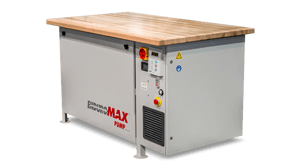 limits the overall pressure output. The design is simpler, requires less moving parts and is often referred to as a “Pressure -Washer” style pump as they operate in exactly the same manner (albeit the Waterjet pumps are of a greatly improved designs). The direct-drive style is also commonly called the “crankshaft” style pump as it utilizes a motor driven “Crankshaft” to move 3 pistons in a rapid succession to intake and pressurize water. Given that there is always one of the 3 cylinders in the compression cycle there is no need for the “Attenuator” to hold and condition the pressure as on the Intensifier style pumps. The water pressure produced is of constant pressure.
limits the overall pressure output. The design is simpler, requires less moving parts and is often referred to as a “Pressure -Washer” style pump as they operate in exactly the same manner (albeit the Waterjet pumps are of a greatly improved designs). The direct-drive style is also commonly called the “crankshaft” style pump as it utilizes a motor driven “Crankshaft” to move 3 pistons in a rapid succession to intake and pressurize water. Given that there is always one of the 3 cylinders in the compression cycle there is no need for the “Attenuator” to hold and condition the pressure as on the Intensifier style pumps. The water pressure produced is of constant pressure.
As there is no hydraulic system on these pumps there is no need for large water cooling systems to keep the pump cool, only a small chiller is recommended to reduce the incoming water temperature to improve seal and check valve life.
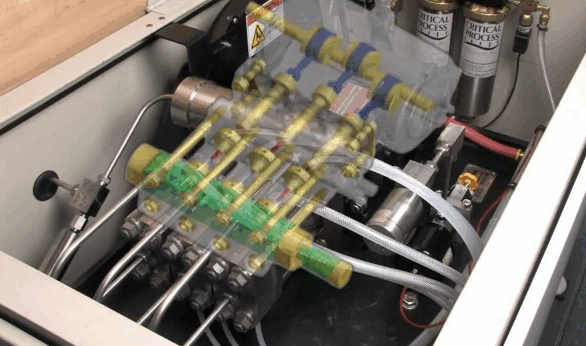 Illustration and Pump Photo courtesy of Omax Corp.
Illustration and Pump Photo courtesy of Omax Corp.
Advantages
-
Electrically Efficient Design
-
No Cooling System Required
-
Quiet Operation
-
Available in Horsepowers from 5HP and Single phase for Home/Hobbyist operation
Disadvantages
-
Limited Pressure (60KPSI Max)
-
Pressure Decreases with operation requiring feedrate or RPM adjustment to maintain cut quality
-
Decreasing/Increasing Pressure Requires RPM Adjustment
Summary:
As different as the two technologies seem, intensifier and crank drive pumps share the same pumping principle: A plunger is pushed into a closed chamber to raise pressure and expel fluid through an outlet check valve; as the direction of the plunger is reversed, low pressure fluid enters the chamber through an inlet check valve. In both cases the continuously reciprocating plunger provides the pumping action. The difference between the two technologies is simply the means by which the plunger is moved. The direct-drive style pump uses a crank similar to the one in an automobile engine while the intensifier style drives the plunger with a hydraulic cylinder, via pressurized oil.
In both pump designs if you increase the available operating horsepower you will increase the volume of water output at the given pressure and that itself, can significantly increase your cutting performance. As an example, with all other factors being equal, the following would apply:
|
Pump Size |
30HP |
50HP |
|
Pump Pressure Output |
60KPSI |
60KPSI |
|
Volume Output |
0.6 GPM |
1.2 GPM |
|
Orifice Size |
0.011” |
0.014” |
|
Material Type/Thickness |
AL / 0.25” |
AL / 0.25” |
|
Cut Quality |
3 |
3 |
|
Abrasive Output |
1LB P/Min |
1LB P/Min |
|
Feedrate |
23.63 IPM |
33.63 IPM |
*Performance Data Achieved using the American Waterjet - Geomate™ Cut Calculator Software
Increased performance in cutting speed of over 40% is achieved in the above example by simply increasing horsepower, which increases the volume of water available at that pressure. That action alone can not only increase cutting speeds but improve performance while keeping operating and maintenance costs well within reason. Adversely increasing pressure indeed does result in increased speeds, but reduces the amount of available water produced at that pressure and thereby reduces overall efficiency. Also these Ultra-High Pressures substantially increase wear thus greatly decreasing the consumable life of your high pressures system components.
With either pump design there has been great strides in performance, efficiency and reliability over the years. Both designs will give your waterjet cutting system performance for many years to come and while the options in Pump Type is hyped up, remember that the most effective manner at cutting efficiently AND affordably on a waterjet is to increase your horsepower NOT your pressure.
If you would like to discuss with one of our experts how a Waterjet Cutting System can work for your application, or if you would like to discuss adding the capability to your next machine just contact the experts at Southern Fabricating Machinery Sales today! Call us directly at 813-444-4555 or visit us on the web at WWW.SOUTHERNFABSALES.COM
Shopping for a Waterjet now? Check out our selection of 2,3 and 5-Axis Waterjet Cutting Systems HERE
Visit our Waterjet Technical Reference Section HERE and sign up to get articles just like this emailed to you when published.
Like this post? You’ll also enjoy:
Waterjets 101: Abrasive Waterjet Machining

